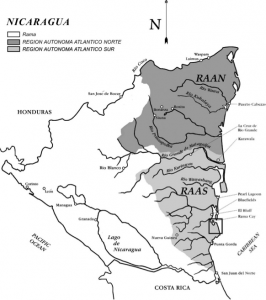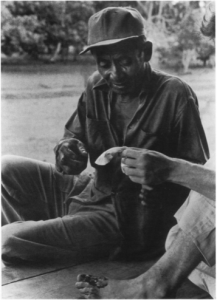Month: September 2015
Blog
About Nicaragua
Herbal Medicine Practice within the Rama and Miskito Indigenous Groups of Nicaragua
Background information
Nicaragua is home to diverse indigenous groups, languages, cultures, and unique practices. Eastern Nicaragua has preserved most of its languages, traditions, and innovations, including its knowledge about medicinal plants, due to its weak interaction with the Spaniards.
The Rama and Miskito are one of the few indigenous groups of eastern Nicaragua. In the Rama region, a total of 206 plant species have been documented, about 75% are native to eastern Nicaragua and are capable of treating more than 30 human diseases. Additionally, over 70% of the plants are believed to have bioactive molecules and mainly are produced as decoctions that are usually administered orally (Coe, 134).
Map of Nicaragua showing the locations of Rama and Miskito settlements.
Midwifery and Medicinal Plants in Rama
Midwifery is common among indigenous people that have limited access to biomedicine/western medicine. Midwives provide health care during pregnancy, childbirth, and postnatal care to both mother and newborn and use a variety of plants to assist a woman through childbirth by using natural procedures. Most of the time, Rama midwives are older women who have given birth several times or who have gained experience by attending births of friends and relatives. Some midwives “undertake long apprenticeships with other experienced midwives in the community” (Coe, 153).
For the past few decades, western medicine care providers, NGO’s, and governmental agencies have tried “to give credence to and incorporate midwifery into the overall health care of women and children in Nicaragua in order to promote midwifery due to the cost and limited access of biomedicine to the people living in rural areas of eastern Nicaragua” (Coe, 134).
Now in many communities of eastern Nicaragua, midwives are trained and certified as traditional birth attendant by the National Ministry of Health and are provided with a basic medical kit needed to perform their work. Since about 70% of births in eastern Nicaragua are attended at home, the aforementioned trainings and certification programs have helped improve maternal–infant health by providing greater access and better quality care.
Rama midwives use a diverse group of plants, about 162 species. Felix Coe, the author of Rama midwifery in eastern Nicaragua, says, “This extensive ethnopharmacopoeia is used to treat the many health issues of pregnancy, parturition, postpartum care, neonatal care, and primary health care of women and children” (Coe, 137).
For example, midwives use a variety of herbal remedies to treat anemia. The most popular remedies for anemia are decoctions. Other common afflictions during pregnancy include backache and constipation, and can be treated with liniments by soaking the roots of feva grass and by placing expecting mothers on a diet that promotes normal bowel movement in conjunction with herbal remedies, respectively.
Medicinal Plants in Miskito
In the coast of Eastern Nicaragua, where the Miskito people are localized, athlete’s foot is a common problem due to the high annual rainfall, causing one’s feet to be constantly wet. Phillip Dennis, the author of Herbal Medicine among the Miskito of Eastern Nicaragua, shares his friend’s experience with herbs and how he was treated. He says:
“A physician friend of mine, who had been suffering from a bad case of athlete's foot, visited Awastara to give a clinic. He had treated himself with all the salves and other anti-fungal preparations available in the Puerto Cabezas hospital, but to no avail. In Awastara, a local bush doctor used the juice from the leaves of Senna alata as indicated, and cured the badly infected feet within a few days. Convinced of its effectiveness, my physician friend asked if he could prescribe.”
Bush doctor treating a physician's foot. Leaves of Senna alata are pounded up in a rag and the thick juice is squeezed onto the skin and allowed to dry.
In addition to athlete’s foot, snakebite is a common problem on the coast. Herbal treatment for snakebite “involves making incisions over the bite and applying poultices of herbs, as well as giving the patient herbal infusions to drink” (Dennis, 25).
Habitat Destruction Consequences
Rama midwives and Miskito bush doctors depend on plants to prepare herbal remedies. Consequently, habitat destruction due to land clearing for agriculture, cattle ranching, or timber extraction has made is very difficult for bush doctors and midwives to obtain essential plant species. Coe says, “Medicinals that once were readily available now require traveling 1–2 days to obtain them” (Coe, 153).
In an effort to have retain these essential species, Rama midwives and Miskito bush doctors collect certain species of plants from the rainforest and transplant them to their home gardens. In an interview with Eva, she says, “You can buy [medicinal plants] but most of the families in Siuna have a small garden with medicinal plants…so usually we take from our gardens…to treat different [diseases].
Medicinal herbs play a critical role in health care systems among poor Nicaraguans and highlight the inherent value of indigenous knowledge. Destruction of the natural ecosystem will affect the 70% of births give at home in Nicaragua, threatens biodiversity, and gradually erases indigenous knowledge.
Resources: https://journeys.dartmouth.edu/arega_lacs20_fa15/2015/11/16/resources-for-final-project/

